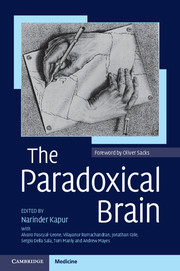Book contents
- Frontmatter
- Contents
- Acknowledgements
- Preface
- Foreword
- Author affiliations
- Abbreviations
- 1 The paradoxical nature of nature
- 2 Paradoxical effects of sensory loss
- 3 Paradoxical functional facilitation and recovery in neurological and psychiatric conditions
- 4 Paradoxes in neurorehabilitation
- 5 The paradoxical self
- 6 Paradoxical psychological functioning in early child development
- 7 Cognitive ageing: a positive perspective
- 8 Paradoxes of learning and memory
- 9 The paradox of human expertise: why experts get it wrong
- 10 Paradoxes in Parkinson's disease and other movement disorders
- 11 Paradoxical phenomena in epilepsy
- 12 Paradoxical creativity and adjustment in neurological conditions
- 13 Paradoxical functional facilitation with noninvasive brain stimulation
- 14 Unexpected benefits of allergies and cigarette smoking: two examples of paradox in neuroepidemiology
- 15 The paradox of autism: why does disability sometimes give rise to talent?
- 16 Paradoxes in creativity and psychiatric conditions
- 17 The paradox of psychosurgery to treat mental disorders
- 18 The paradox of electroconvulsive therapy
- 19 Paradoxes of comparative cognition
- 20 Paradoxical phenomena in brain plasticity
- 21 Immature neurons in the adult brain. Breaking all the rules
- 22 The paradoxical hippocampus: when forgetting helps learning
- 23 Paradoxical effects of drugs on cognitive function: the neuropsychopharmacology of the dopamine and other neurotransmitter systems
- 24 The paradoxical brain – so what?
- Index
- References
18 - The paradox of electroconvulsive therapy
Published online by Cambridge University Press: 05 December 2011
- Frontmatter
- Contents
- Acknowledgements
- Preface
- Foreword
- Author affiliations
- Abbreviations
- 1 The paradoxical nature of nature
- 2 Paradoxical effects of sensory loss
- 3 Paradoxical functional facilitation and recovery in neurological and psychiatric conditions
- 4 Paradoxes in neurorehabilitation
- 5 The paradoxical self
- 6 Paradoxical psychological functioning in early child development
- 7 Cognitive ageing: a positive perspective
- 8 Paradoxes of learning and memory
- 9 The paradox of human expertise: why experts get it wrong
- 10 Paradoxes in Parkinson's disease and other movement disorders
- 11 Paradoxical phenomena in epilepsy
- 12 Paradoxical creativity and adjustment in neurological conditions
- 13 Paradoxical functional facilitation with noninvasive brain stimulation
- 14 Unexpected benefits of allergies and cigarette smoking: two examples of paradox in neuroepidemiology
- 15 The paradox of autism: why does disability sometimes give rise to talent?
- 16 Paradoxes in creativity and psychiatric conditions
- 17 The paradox of psychosurgery to treat mental disorders
- 18 The paradox of electroconvulsive therapy
- 19 Paradoxes of comparative cognition
- 20 Paradoxical phenomena in brain plasticity
- 21 Immature neurons in the adult brain. Breaking all the rules
- 22 The paradoxical hippocampus: when forgetting helps learning
- 23 Paradoxical effects of drugs on cognitive function: the neuropsychopharmacology of the dopamine and other neurotransmitter systems
- 24 The paradoxical brain – so what?
- Index
- References
Summary
Summary
One of the most dramatic paradoxes in psychiatry is the mechanism of action and efficacy of electroconvulsive therapy (ECT), in which people are anaesthesized and given an electric shock sufficient to produce an epileptic seizure. Although known for over 70 years, many of the hypothesized underlying mechanisms still remain unresolved and under debate. The practice of ECT has evolved into a complex procedure and its application worldwide has had extensive clinical impact in the field of neuropsychiatric disorders. Within this background, we report on current neurophysiological models of ECT, its efficacy and further questions and directions of its use. The chapter reports how the paradox that an epileptic seizure has a beneficial effect on mood has influenced our understanding of brain pathologies.
Introduction
There is arguably no treatment more negatively judged, no treatment more controversially discussed and no treatment more effective in psychiatry than electroconvulsive therapy (ECT). This treatment raises a number of different paradoxes: first, why is a highly effective treatment perceived so negatively at the same time? Second, why can this treatment work at the same time in conditions with increased dopaminergic neurotransmission (like psychosis) and in diseases with decreased dopaminergic neurotransmission (like Parkinson's disease)? Third, why does this therapy work at the same time as an intervention against depression and against mania? And fourth, the main paradox: why does a treatment based on the repetitive induction of generalized seizure activity not lead to considerable brain damage but – on the contrary – have beneficial effects?
- Type
- Chapter
- Information
- The Paradoxical Brain , pp. 321 - 331Publisher: Cambridge University PressPrint publication year: 2011



